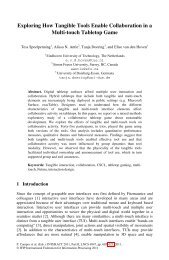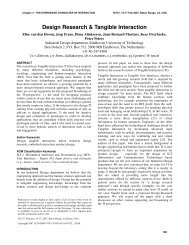Sissy - Elise van den Hoven
Sissy - Elise van den Hoven
Sissy - Elise van den Hoven
Create successful ePaper yourself
Turn your PDF publications into a flip-book with our unique Google optimized e-Paper software.
offering a new way to see or think about something;<br />
you are developing the very concepts that you and<br />
others later on (including social scientists) will use<br />
to understand and evaluate a phenomenon in a new<br />
light. [0]<br />
Reconciling the Two Approaches<br />
It is evi<strong>den</strong>t that these are two very different<br />
approaches. As a result mutual criticism between the<br />
two disciplines has emerged.<br />
Ethnomethodologists lament “the wholesale<br />
importation of cultural theory (via media studies and so<br />
on) into the field of HCI. Indeed, the signature of these<br />
new ‘reflexive’ ethnographies increasingly gaining<br />
exposure within CHI. This brings in other cultural<br />
‘standpoints’ that provide existential conditions for<br />
reflexive critiques of dominant discourses” [0].<br />
Crabtree argues that the problem with critically<br />
informed approaches is that their inherent need to<br />
deconstruct all that they it encounter results in findings<br />
that meet the agenda of the researcher. The needs of the<br />
user become peripheral in the quest to fulfill this<br />
agenda. It is for this reason that new approaches, while<br />
alluring, fail to provide sufficiently detailed social<br />
analyses to ground design in what people do [0]<br />
Most significantly, the rejection of theory by<br />
ethnomethodology continues to act as a metaphorical<br />
red flag for those wishing to adopt more culturally<br />
situated HCI approaches. These debates are becoming<br />
increasing evi<strong>den</strong>t during conference presentations, and<br />
are played out regularly in HCI blogs.<br />
Having discussed the divergent characteristics of the<br />
two approaches, we will now explore the possibility for<br />
the two methodologies to combine together in a<br />
complimentary manner. The next sections will illustrate<br />
how the two approaches can coexist, by examining the<br />
application of these two approaches.<br />
The cultural theory perspective<br />
Recent interpretations of critically informed HCI has<br />
seen agendas such as Feminism shape analytical lenses<br />
[0]. When applied to the data from the user study this<br />
meant a feminist critique was used to better understand<br />
the way in which gender is constructed and the role that<br />
technology plays in shaping notions of ‘the body’.<br />
Focusing on this issue drew attention to the way in<br />
which three of the mothers in the families participating<br />
in the study were reluctant to reveal their age. Rather<br />
than attempting to gather information about their age in<br />
order to keep with preconceived ideas of what our data<br />
should look like, this indicated the potential to<br />
recognize and reshape our research questions so they<br />
are more in keeping with cultural mores and taboos.<br />
Thus, rather than seeing the lack of data about specific<br />
age as being problematic, this indicated an opportunity<br />
to i<strong>den</strong>tify and address an important methodological<br />
challenge.<br />
36<br />
In addition to indicating the need to rethink the way in<br />
which we approach the question of age, the reoccurring<br />
reluctance to reveal age also tells us something about<br />
the female’s relationship with her own body. For<br />
example, one of the women who did not wish to<br />
disclose her age also reported than when it was her turn<br />
to engage with the Kinect in front of other people she<br />
felt embarrassed and conspicuous, and a pregnant<br />
participant felt that it heightened awareness of her<br />
condition.<br />
From a cultural theory point of view the data tells us<br />
about the complex and unique relationships that women<br />
have with their changing bodies and the need for design<br />
approaches that are sensitive enough to allow for this.<br />
The Interaction Analysis perspective<br />
When comparing the two approaches, what is<br />
immediately evi<strong>den</strong>t is that the ethno methodological<br />
approach told us virtually nothing about gender. This is<br />
not because ethnomethodology set out to ignore power<br />
structures relating to gender completely, but rather that<br />
it would only flag them if it were found to emerge from<br />
the users’ interactions. The lack of gender related<br />
insights could mainly be attributed to the way in which<br />
ethnomethodology resists drawing on performed; thus<br />
distancing notions of the domestic space as being one<br />
that is zoned according to gender.<br />
An exception to this is that when the interview data was<br />
included in the analysis the issues regarding the<br />
women’s reluctance to reveal age did arise. But this<br />
type of data is secondary in the Interaction Analysis<br />
approach and there was nothing in the actual video data<br />
itself to suggest gender related concerns were at work.<br />
We must then ask ourselves, was the issue of gender in<br />
the interview transcripts merely an extension of the<br />
researcher’s own background in cultural theory – what<br />
Crabtree would call an example of the researcher<br />
implanting their own theoretical concerns in place of<br />
those of the user’s concerns? Or does it indicate the<br />
importance of extending ethnomethodological notions<br />
of what constitutes data so that previously secondary<br />
sources such as interview data become included as<br />
primary sources?<br />
CONCLUSION<br />
One of the characteristics of HCI is that it has remained<br />
a relatively un-politicized space. The third wave of<br />
critically informed design methodologies we are now<br />
heading into will bring about change, one of which is<br />
the emergence of new politicized HCI design space.<br />
For example, the introduction of Feminist HCI will<br />
mean we forever lose the previous HCI construction of<br />
the ‘user’ as genderless beings. So although these<br />
theories will bring many benefits to the design of new<br />
technologies, the culturally loaded nature of these<br />
discourses will change the landscape of HCI as for<br />
example, as increasing awareness of gender pushes out<br />
an ambiguity towards it. The importance of this<br />
ambiguity should not be underestimated.



![Download 1.8 MB [pdf] - Elise van den Hoven](https://img.yumpu.com/18078175/1/190x245/download-18-mb-pdf-elise-van-den-hoven.jpg?quality=85)

![Download 0.2 MB [pdf] - Elise van den Hoven](https://img.yumpu.com/18078145/1/182x260/download-02-mb-pdf-elise-van-den-hoven.jpg?quality=85)
![Download 0.1 MB [pdf] - Elise van den Hoven](https://img.yumpu.com/18078125/1/190x146/download-01-mb-pdf-elise-van-den-hoven.jpg?quality=85)
![Download 1.9 MB [pdf] - Elise van den Hoven](https://img.yumpu.com/18078041/1/182x260/download-19-mb-pdf-elise-van-den-hoven.jpg?quality=85)

